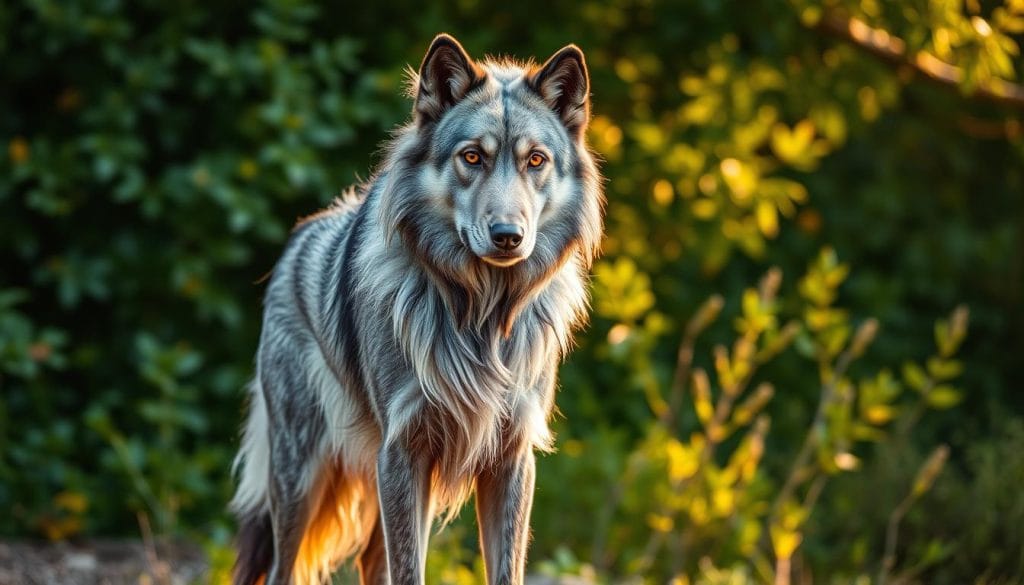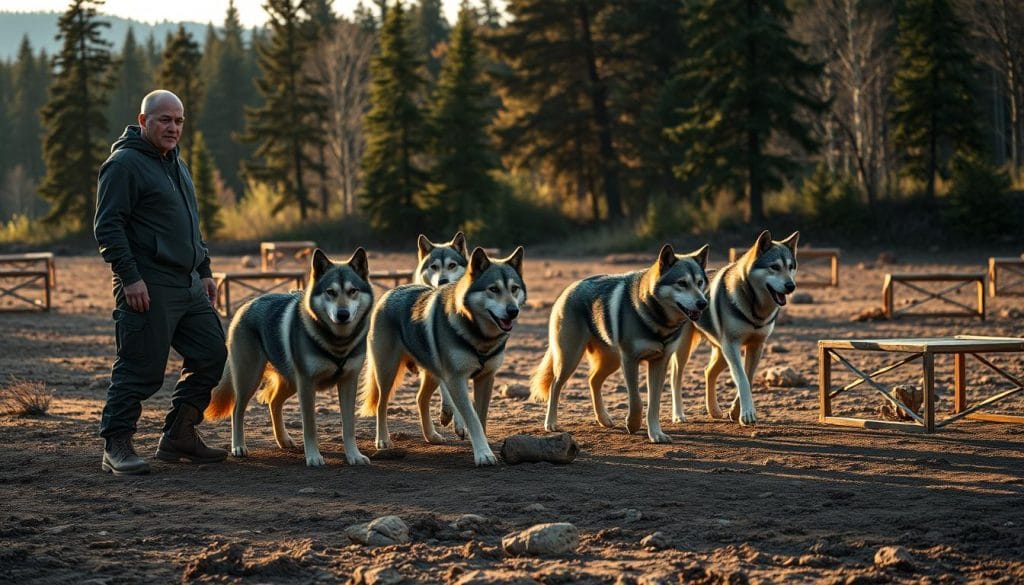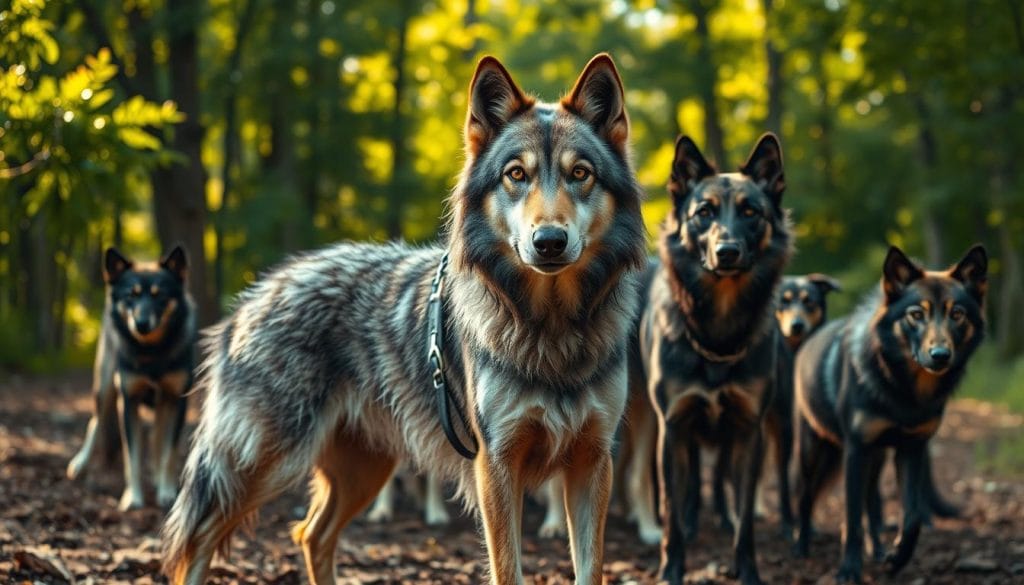Wolf Dog Breeds: Unique Canine Companions
Did you know some wolf-like dogs are bred to capture the wild spirit of their ancestors? These unique canine companions have amazed people for centuries. They mix wild beauty with loyal friendship.

Exploring wolf dog breeds reveals their special traits. They are smart, loyal, and full of energy. This makes them perfect for active families or those who can give them the care they need.
Key Takeaways
- Wolf dog breeds are known for their intelligence and loyalty.
- These breeds require active owners who can provide necessary exercise and training.
- Wolf-like dogs have unique characteristics that distinguish them from other breeds.
- Understanding the needs of wolf dog breeds is crucial for their care.
- These breeds can make great companions for the right owner.
Understanding Wolf Dogs
Exploring unique canine companions means knowing what a wolf dog is. Wolf dogs, or wolf-dog hybrids, are a mix of a wolf and a domestic dog. They show traits from both parents.
What Defines a Wolf Dog
A wolf dog’s genetic makeup is key. It has a mix of wolf and dog ancestry. The wolf content percentage affects its behavior, physiology, and looks.
Wolf dogs are not just about their ancestry. They also have distinctive physical characteristics. These include sharp features, muscular builds, and thick coats.
Wolf Content Percentages Explained
The wolf content percentage shows how much wolf ancestry a wolf dog has. This percentage is important because it affects their behavior and looks. For example:
- Low-content wolf dogs (1-49% wolf ancestry) act more like domestic dogs.
- Mid-content wolf dogs (50-74% wolf ancestry) show a mix of dog and wolf behaviors.
- High-content wolf dogs (75% or higher wolf ancestry) mostly act like wolves.
Temperament and Behavioral Traits
Wolf dogs’ temperaments and behaviors vary. They depend on their wolf content and individual personalities. Wolf dogs are known for their intelligence, energy, and strong prey drive. They need experienced owners who can train, socialize, and exercise them.
Knowing these traits helps create the right environment. Important behaviors include:
- High energy levels needing regular exercise.
- Independent nature, making training hard.
- Strong pack dynamics, needing clear leadership.
Popular Wolf Dog Breeds and Their Characteristics
Wolf dogs are fascinating because of their different traits and needs. Knowing these is key for anyone thinking of getting one.
Czechoslovakian Wolfdog
The Czechoslovakian Wolfdog is strong and smart. It was made for military work. This breed needs lots of exercise and is easy to train.
Saarloos Wolfdog
The Saarloos Wolfdog looks like a wolf and is rare. It needs an experienced owner. It’s quiet and needs to be socialized well.
Alaskan Malamute
Alaskan Malamutes are tough and built for long walks. They like to do things on their own. They need regular training and exercise.
Siberian Husky
Siberian Huskies are friendly and full of energy. They love people and need lots of activity. They also need something to keep their minds busy.
Northern Inuit Dog
Northern Inuit Dogs look like wolves but are friendly. They are smart and need to stay active.
Tamaskan
Tamaskan dogs look like wolves and are very smart. They are good at learning and need lots of activity.
Here’s a table to help you see how these breeds differ:
| Breed | Energy Level | Trainability | Socialization Needs |
| Czechoslovakian Wolfdog | High | High | High |
| Saarloos Wolfdog | Medium | Medium | High |
| Alaskan Malamute | High | Medium | Medium |
| Siberian Husky | High | High | High |
| Northern Inuit Dog | High | High | High |
| Tamaskan | High | High | Medium |
Choosing a wolf dog breed is a big decision. It depends on your lifestyle and what the breed needs. Knowing each breed’s unique traits helps you make the best choice.
Legal Considerations Before Getting a Wolf Dog
Before getting a wolf dog, it’s key to know the laws. Laws about wolf dogs vary across the US. This makes it a big issue for those wanting to own one.
State and Local Regulations in the US
States have different rules for wolf dog ownership. Some ban them, while others need special permits. For example, California and New York have strict rules. But, other states might be more relaxed. Always check your state’s laws.
How to Obtain Required Permits and Licenses
To own a wolf dog legally, you might need special permits. You’ll need to apply, pay a fee, and possibly have your home checked. The exact steps vary, so contact your local animal control for details.
Insurance Requirements and Finding Coverage
Finding insurance for wolf dogs can be hard. Many companies see them as high-risk. But, some providers offer policies for wolf dog owners. Look around to find the right coverage for you.
Legal Responsibilities as an Owner
As a wolf dog owner, you’re responsible for your pet’s actions. This includes any damage or injuries. Training and socializing your wolf dog can help. You might also need to take steps to prevent escapes or harm.
How to Prepare Your Home for a Wolf Dog
Before you bring a wolf dog home, make sure your house is ready. Wolf dogs need a safe and welcoming place to live. They have special needs that require attention to their living space.
Creating Secure Outdoor Enclosures
A safe outdoor area is key for wolf dogs. They love to roam and explore. Use high-quality fencing that’s at least 6 feet tall and goes 3 feet underground to stop them from escaping.
The enclosure should also protect your wolf dog from other animals and bad weather.
Wolfproofing Your Indoor Space
Wolfproofing your indoor space is just as important. Wolf dogs are curious and full of energy. Remove any dangerous materials or objects that could get damaged or be a risk.
Secure loose wires, toxic substances, and fragile items. Consider getting durable furniture that can handle their energetic play.
Enrichment Setup for Mental Stimulation
Wolf dogs need mental stimulation to avoid boredom and stress. Provide activities like puzzle toys filled with treats, scent work, or interactive games. These keep them engaged and happy.
Change these activities often to keep your wolf dog interested and stimulated.
Safety Measures for Visitors and Family
When visitors or new family members meet your wolf dog, safety is key. Make sure your wolf dog is well-socialized and knows basic commands. Always watch interactions closely.
Teach your guests how to safely and respectfully interact with your wolf dog.
Feeding and Caring for Wolf Dog Breeds
To keep your wolf dog healthy and happy, focus on their diet and exercise. A balanced diet and regular activity are key to their well-being.
Designing an Appropriate Diet Plan
When planning your wolf dog’s diet, think about their nutritional needs. They need a lot of protein and some fat. Consult with a veterinarian to find the right diet for your wolf dog’s age, size, and activity level.
Raw vs. Commercial Food Options
You can feed your wolf dog raw food or commercial dog food. Raw food diets are natural and good for wolf dogs. But, commercial dog food is convenient and balanced. Choose what’s best for you and your pet.
Establishing Feeding Routines
It’s important to have a regular feeding schedule for your wolf dog. Feed them at the same times every day. This keeps their digestive system healthy and prevents overeating. The number of meals depends on their age and how active they are.
Exercise Requirements and Schedules
Wolf dogs are very energetic and need lots of exercise. Aim for at least 1-2 hours of physical activity daily. This can be walks, runs, or playtime. A schedule helps make sure they get enough exercise.
Step-by-Step Training Guide for Wolf Dogs
Starting to train your wolf dog is exciting. It’s key to build trust and clear communication. Training a wolf dog needs patience, understanding, and a special approach.
Establishing Leadership Without Dominance
When training a wolf dog, leading without being too strict is important. You should set clear rules and be a steady, calm guide. Positive reinforcement is a great method. It rewards good behavior instead of punishing bad ones.

Basic Command Training Techniques
Basic commands are the first steps to a well-behaved wolf dog. Start with simple ones like « sit, » « stay, » and « come. » Use positive reinforcement techniques like treats and praise to help them learn.
| Command | Technique | Reward |
| Sit | Hold treat above head | Treat, Praise |
| Stay | Take steps back, hand signal | Treat, Praise |
| Come | Use excited tone, open arms | Treat, Praise |
Leash Training and Public Behavior
Leash training is crucial for walking your wolf dog in public. Start by getting them used to a harness, then the leash. Practice in a safe area before going out in public.
Working with Specialized Trainers
Specialized trainers can be a big help, especially if you’re new to owning a wolf dog. They give advice and methods for specific problems.
Finding the Right Professional
When looking for a trainer, find one with experience with wolf dogs. Ask for references and watch a training session. This helps you see if their methods fit your dog.
What to Expect from Training Sessions
Training sessions should be organized but also flexible. They should match your dog’s learning speed. You’ll see obedience training, socialization, and help with issues like leash pulling or fear.
Socializing Your Wolf Dog
Socializing your wolf dog is key to their positive interactions with people and animals. It’s not just about introducing them to new things. It’s about doing it safely and in control.
Early Socialization Timeline and Methods
The early life of a wolf dog is vital for socialization. Start between 8 to 11 weeks old by exposing them to different places, people, and animals. This helps build their confidence and prevents fear-based aggression.
Use treats and praise to encourage good behavior. Gradually make the situations more complex.
Safe Introduction to Other Animals
Introduce your wolf dog to other animals in a neutral area. Watch their body language for stress or aggression signs like growling or raised hackles.
Start with visual introductions, then move to face-to-face interactions under close watch. Reward calm behavior.
Managing Interactions with Strangers
Wolf dogs may be cautious around strangers. Teach them to see strangers as positive, like with treats. Gradually introduce them to different people, keeping them calm.
Recognizing and Addressing Stress Signals
Know the stress signals in your wolf dog, like panting or yawning. If you see these signs, calmly remove them from the stressful situation.
Understanding and acting on these signals can stop more serious behavior problems.
Health Management for Wolf Dog Breeds
Keeping your wolf dog healthy means knowing their special needs. Wolf dogs, a mix of wolf and dog, need careful attention to their health.
Finding Wolf Dog Experienced Veterinarians
Finding a vet who knows wolf dogs is key. Not all vets can handle their unique health needs. It’s important to find one who does.
Tips for Finding the Right Veterinarian:
- Ask other wolf dog owners or breeders for vet recommendations.
- Check if the vet has experience with exotic or hybrid animals.
- Ask about their approach to preventative care and emergencies.
Preventative Care Schedule
A good preventative care plan is essential. This includes regular shots, parasite control, and dental care. Your vet can create a plan for your wolf dog.
| Preventative Measure | Frequency | Importance |
| Vaccinations | Annually | High |
| Parasite Control | Monthly | High |
| Dental Care | Every 6 months | Medium |
Handling Common Health Issues
Wolf dogs may face health issues like hip dysplasia, eye problems, and heart issues. Knowing these can help spot them early.

Emergency Preparedness for Wolf Dog Owners
Being ready for emergencies is crucial. Have a first aid kit, know basic first aid, and have a plan for vet visits.
Emergency Preparedness Tips:
- Keep emergency contact numbers handy, like your vet and a nearby animal hospital.
- Have a pet first aid kit ready.
- Learn to recognize when your wolf dog is sick or distressed.
Conclusion
Exploring wolf dog breeds shows they offer both joys and challenges. To own a wolf dog, you must understand their needs and legal duties.
With the right knowledge, you can decide if owning a wolf dog is for you. Preparing your home and knowing their diet and training needs are key. These steps help create a happy and healthy bond with your wolf dog.
Starting this journey means more than just having a pet. It’s about living a life that puts your wolf dog’s happiness first. With the right attitude and preparation, the bond with your wolf dog can be incredibly rewarding. They become a truly special companion.
FAQ
What is a wolf dog breed?
A wolf dog breed is a mix of a domestic dog and a wolf. It looks and acts like a wolf.
Are wolf dog breeds legal to own?
Laws about owning wolf dog breeds vary by place. Always check your local laws before getting one.
How do I care for a wolf dog’s dietary needs?
Wolf dogs need a diet full of protein and fat. They might do well on a raw diet. Talk to a vet or animal nutritionist for advice.
Can wolf dogs be trained like regular dogs?
Yes, wolf dogs can learn. But they need a patient owner who can teach them without being too strict. They also need lots of training and socializing.
How much exercise do wolf dogs need?
Wolf dogs are very active. They need lots of running, hiking, or playtime to stay happy and healthy.
Are wolf dogs good with children?
Wolf dogs can get along with kids if they’re raised together. But they might not be best for very young children because of their energy and strength.
How do I find a veterinarian experienced in caring for wolf dogs?
Ask other wolf dog owners for vet recommendations. Or look online for vets who know about exotic animals.
What are some common health issues in wolf dogs?
Wolf dogs might get hip dysplasia, eye problems, or genetic diseases. Regular vet visits can catch these early.
Can I insure my wolf dog?
Some insurance covers wolf dogs, but it’s hard to find. Premiums might be high because of the risks.
How do I prepare my home for a wolf dog?
To get your home ready, create a safe outdoor area. Make your indoor space wolfproof. Also, give your wolf dog things to do to keep their mind busy.
Share this content:


